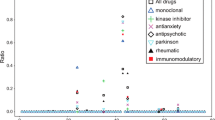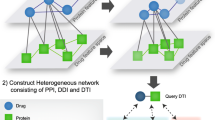Abstract
Proteins rarely function in isolation inside and outside cells, but operate as part of a highly interconnected cellular network called the interaction network. Therefore, the analysis of the properties of drug-target proteins in the biological network is especially helpful for understanding the mechanism of drug action in terms of informatics. At present, no detailed characterization and description of the topological features of drug-target proteins have been available in the human protein-protein interaction network. In this work, by mapping the drug-targets in DrugBank onto the interaction network of human proteins, five topological indices of drug-targets were analyzed and compared with those of the whole protein interactome set and the non-drug-target set. The experimental results showed that drug-target proteins have higher connectivity and quicker communication with each other in the PPI network. Based on these features, all proteins in the interaction network were ranked. The results showed that, of the top 100 proteins, 48 are covered by DrugBank; of the remaining 52 proteins, 9 are drug-target proteins covered by the TTD, Matador and other databases, while others have been demonstrated to be drug-target proteins in the literature.
Similar content being viewed by others
References
Nabieva E, Jim K, Agarwal A, et al. Whole-proteome prediction of protein function via graph-theoretic analysis of interaction maps. Bioinformatics, 2005, 21(Suppl 1): i302–310 15961472, 10.1093/bioinformatics/bti1054, 1:CAS:528:DC%2BD2MXlslyktb4%3D
Vazquez A, Flammini A, Maritan A, et al. Global protein function prediction from protein-protein interaction networks. Nat Biotechnol, 2003, 21(6): 697–700 12740586, 10.1038/nbt825, 1:CAS:528:DC%2BD3sXktFSlu70%3D
Gao L, Li X, Guo Z, et al. Widely predicting specific protein functions based on protein-protein interaction data and gene expression profile. Sci China C-Life Sci, 2007, 50(1): 125–134 17393093, 10.1007/s11427-007-0009-1, 1:CAS:528:DC%2BD2sXkt1agu70%3D
Zhu M, Gao L, Guo Z, et al. Globally predicting protein functions based on co-expressed protein-protein interaction networks and ontology taxonomy similarities. Gene, 2007, 391(1–2): 113–119 17289301, 10.1016/j.gene.2006.12.008, 1:CAS:528:DC%2BD2sXis1Clu7o%3D
Rivas E, Eddy S R. A dynamic programming algorithm for RNA structure prediction including pseudoknots. J Mol Biol, 1999, 285(5): 2053–2068 9925784, 10.1006/jmbi.1998.2436, 1:CAS:528:DyaK1MXhtV2hsLg%3D
George R A, Liu J Y, Feng L L, et al. Analysis of protein sequence and interaction data for candidate disease gene prediction. Nucleic Acids Res, 2006, 34(19): e130 17020920, 10.1093/nar/gkl707
Uetz P, Hughes R E. Systematic and large-scale two-hybrid screens. Curr Opin Microbiol, 2000, 3(3): 303–308 10851163, 10.1016/S1369-5274(00)00094-1, 1:CAS:528:DC%2BD3cXksFSns70%3D
Gavin A C, Bosche M, Krause R, et al. Functional organization of the yeast proteome by systematic analysis of protein complexes. Nature, 2002, 415(6868): 141–147 11805826, 10.1038/415141a, 1:CAS:528:DC%2BD38XmsVCgtw%3D%3D
Mewes H W, Dietmann S, Frishman D, et al. MIPS: analysis and annotation of genome information in 2007. Nucleic Acids Res, 2008, 36(Database issue): D196–201 18158298, 1:CAS:528:DC%2BD1cXhtVSku7c%3D
Stark C, Breitkreutz B J, Reguly T, et al. BioGRID: a general repository for interaction datasets. Nucleic Acids Res, 2006, 34(Database issue): D535–539 16381927, 10.1093/nar/gkj109, 1:CAS:528:DC%2BD28XisFyhsA%3D%3D
Chen Y, Xu D. Global protein function annotation through mining genome-scale data in yeast Saccharomyces cerevisiae. Nucleic Acids Res, 2004, 32(21): 6414–6424 15585665, 10.1093/nar/gkh978, 1:CAS:528:DC%2BD2cXhtVOjs73I
Karaoz U, Murali T M, Letovsky S, et al. Whole-genome annotation by using evidence integration in functional-linkage networks. Proc Natl Acad Sci USA, 2004, 101(9): 2888–2893 14981259, 10.1073/pnas.0307326101, 1:CAS:528:DC%2BD2cXitlWhsLw%3D
Jiang T, Keating A E. AVID: an integrative framework for discovering functional relationships among proteins. BMC Bioinformatics, 2005, 6: 136 15929793, 10.1186/1471-2105-6-136
Xu J, Li Y. Discovering disease-genes by topological features in human protein-protein interaction network. Bioinformatics, 2006, 22(22): 2800–2805 16954137, 10.1093/bioinformatics/btl467, 1:CAS:528:DC%2BD28XhtFyqtrfK
Wishart D S, Knox C, Guo A C, et al. DrugBank: a knowledgebase for drugs, drug actions and drug targets. Nucleic Acids Res, 2008, 36(Database issue): D901–906 18048412, 1:CAS:528:DC%2BD1cXhtVSrs7Y%3D
Reguly T, Breitkreutz A, Boucher L, et al. Comprehensive curation and analysis of global interaction networks in Saccharomyces cerevisiae. J Biol, 2006, 5(4): 11 16762047, 10.1186/jbiol36
Tu Z, Wang L, Xu M, et al. Further understanding human disease genes by comparing with housekeeping genes and other genes. BMC Genomics, 2006, 7: 31 16504025, 10.1186/1471-2164-7-31
Yildirim M A, Goh K I, Cusick M E, et al. Drug-target network. Nat Biotechnol, 2007, 25(10): 1119–1126 17921997, 10.1038/nbt1338, 1:CAS:528:DC%2BD2sXhtFagt7rO
Wuchty S, Almaas E. Peeling the yeast protein network. Proteomics, 2005, 5(2): 444–449 15627958, 10.1002/pmic.200400962, 1:CAS:528:DC%2BD2MXhs1Oitb0%3D
Wachi S, Yoneda K, Wu R. Interactome-transcriptome analysis reveals the high centrality of genes differentially expressed in lung cancer tissues. Bioinformatics, 2005, 21(23): 4205–4208 16188928, 10.1093/bioinformatics/bti688, 1:CAS:528:DC%2BD2MXht1Gltr7M
Wang J, Yang Y, Xia H H, et al. Suppression of FHL2 expression induces cell differentiation and inhibits gastric and colon carcinogenesis. Gastroenterology, 2007, 132(3): 1066–1076 17383428, 10.1053/j.gastro.2006.12.004, 1:CAS:528:DC%2BD2sXkslCis74%3D
Maloney A, Workman P. HSP90 as a new therapeutic target for cancer therapy: the story unfolds. Expert Opin Biol Ther, 2002, 2(1): 3–24 11772336, 10.1517/14712598.2.1.3, 1:CAS:528:DC%2BD38XnsVaksw%3D%3D
James C R, Quinn J E, Mullan P B, et al. BRCA1, a potential predictive biomarker in the treatment of breast cancer. Oncologist, 2007, 12(2): 142–150 17296808, 10.1634/theoncologist.12-2-142, 1:CAS:528:DC%2BD2sXjtFChsLo%3D
Horiuchi K, Weskamp G, Lum L, et al. Potential role for ADAM15 in pathological neovascularization in mice. Mol Cell Biol, 2003, 23(16): 5614–5624 12897135, 10.1128/MCB.23.16.5614-5624.2003, 1:CAS:528:DC%2BD3sXmt1Srt78%3D
Raponi M, Harousseau J L, Lancet J E, et al. Identification of molecular predictors of response in a study of tipifarnib treatment in relapsed and refractory acute myelogenous leukemia. Clin Cancer Res, 2007, 13(7): 2254–2260 17404110, 10.1158/1078-0432.CCR-06-2609, 1:CAS:528:DC%2BD2sXjs12rtb8%3D
Hutson S M, Lieth E, LaNoue K F. Function of leucine in excitatory neurotransmitter metabolism in the central nervous system. J Nutr, 2001, 131(3): 846S–850S 11238772, 1:STN:280:DC%2BD3M3hs1agtA%3D%3D
Doggrell S A. Bradykinin B2 receptors as a target in diabetic nephropathy. Curr Opin Investig Drugs, 2006, 7(3): 251–255 16555685, 1:CAS:528:DC%2BD28XjsVOks7g%3D
Author information
Authors and Affiliations
Corresponding authors
Additional information
Supported by National Natural Science Foundation of China (Grant No. 30370798, 30571034 and 30570424), National High-Tech Research and Development Program of China (Grant No. 2007AA02Z329), National Basic Research Program of China (Grant No. 2008CB517302), Natural Science Foundation of Heilongjiang Province, China (Grant No. ZJG0501, 1055HG009, GB03C602-4 and BMFH060044), New Century Hundred-Thousand-Ten Thousand Talents Project of Beijing City, Scientific Research Common Program of Beijing Municipal Commission of Education (KM200610025011).
Rights and permissions
About this article
Cite this article
Zhu, M., Gao, L., Li, X. et al. Identifying drug-target proteins based on network features. SCI CHINA SER C 52, 398–404 (2009). https://doi.org/10.1007/s11427-009-0055-y
Received:
Accepted:
Published:
Issue Date:
DOI: https://doi.org/10.1007/s11427-009-0055-y




